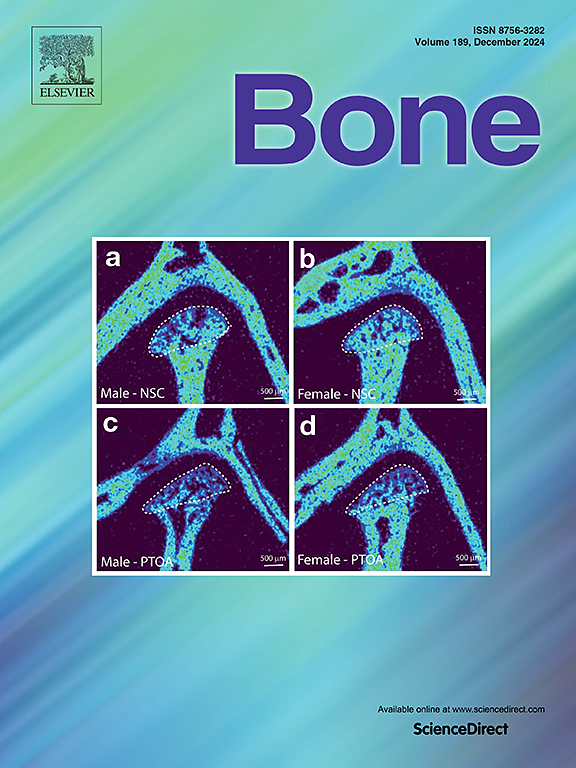Unplanned emergency room visits within 30 and 90 days after osteoporotic hip fracture surgery: A comprehensive risk factor analysis
IF 3.5
2区 医学
Q2 ENDOCRINOLOGY & METABOLISM
引用次数: 0
Abstract
Hip fractures in older adults are associated with high comorbidity and mortality rates. Despite efforts to reduce hospital stay, early emergency room (ER) visits and readmissions remain common and can negatively impact outcomes. In this study, we aimed to evaluate the incidence, causes, and risk factors of unplanned ER visits within 30 and 90 days following hip fracture surgery. A retrospective review was conducted of 4551 patients who underwent hip fracture surgery at a single institution between 2005 and 2024. Demographics, perioperative variables, and clinical risk factors were analyzed using univariate and multivariate logistic regression. ER visits within 30 and 90 days post-discharge were categorized as surgical or non-surgical and compared with control groups without ER visits. The rates of unplanned ER visits were 6.8 % within 30 days and 12.2 % within 90 days after discharge. Multivariate analysis identified low body mass index (BMI) and higher Charlson Comorbidity Index scores as significant risk factors for ER visits at both time points. Non-surgical complications—most commonly gastrointestinal and pulmonary—were the leading causes of ER visits. Among surgical complications, hip arthroplasty dislocation was the most frequent cause at both 30 and 90 days. Unplanned ER visits following hip fracture surgery are primarily driven by non-surgical complications. Low BMI and poor preoperative comorbidity status are key risk factors. Targeted preventive strategies, including those addressing modifiable surgical risks, such as prosthetic dislocation, may help reduce ER utilization and improve postoperative outcomes.
骨质疏松性髋部骨折术后30天和90天内意外急诊室就诊:综合危险因素分析
老年人髋部骨折具有较高的合并症和死亡率。尽管努力减少住院时间,早期急诊室(ER)访问和再入院仍然很常见,并可能对结果产生负面影响。在这项研究中,我们旨在评估髋部骨折术后30天和90天内计划外急诊室就诊的发生率、原因和危险因素。对2005年至2024年间在同一家机构接受髋部骨折手术的4551例患者进行了回顾性研究。采用单因素和多因素logistic回归分析人口统计学、围手术期变量和临床危险因素。出院后30天和90天的急诊室就诊分为手术和非手术,并与没有急诊室就诊的对照组进行比较。出院后30天内的计划外就诊率为6.8%,90天内的计划外就诊率为12.2%。多变量分析发现,在两个时间点,较低的身体质量指数(BMI)和较高的Charlson合并症指数得分是就诊的重要危险因素。非手术并发症——最常见的是胃肠道和肺部——是急诊室就诊的主要原因。在手术并发症中,髋关节置换术脱位是30天和90天最常见的原因。髋部骨折手术后的计划外急诊主要是由非手术并发症驱动的。低BMI和术前不良合并症是关键的危险因素。有针对性的预防策略,包括解决可改变的手术风险,如假体脱位,可能有助于减少急诊室的利用和改善术后结果。
本文章由计算机程序翻译,如有差异,请以英文原文为准。
求助全文
约1分钟内获得全文
求助全文
来源期刊

Bone
医学-内分泌学与代谢
CiteScore
8.90
自引率
4.90%
发文量
264
审稿时长
30 days
期刊介绍:
BONE is an interdisciplinary forum for the rapid publication of original articles and reviews on basic, translational, and clinical aspects of bone and mineral metabolism. The Journal also encourages submissions related to interactions of bone with other organ systems, including cartilage, endocrine, muscle, fat, neural, vascular, gastrointestinal, hematopoietic, and immune systems. Particular attention is placed on the application of experimental studies to clinical practice.
 求助内容:
求助内容: 应助结果提醒方式:
应助结果提醒方式:


